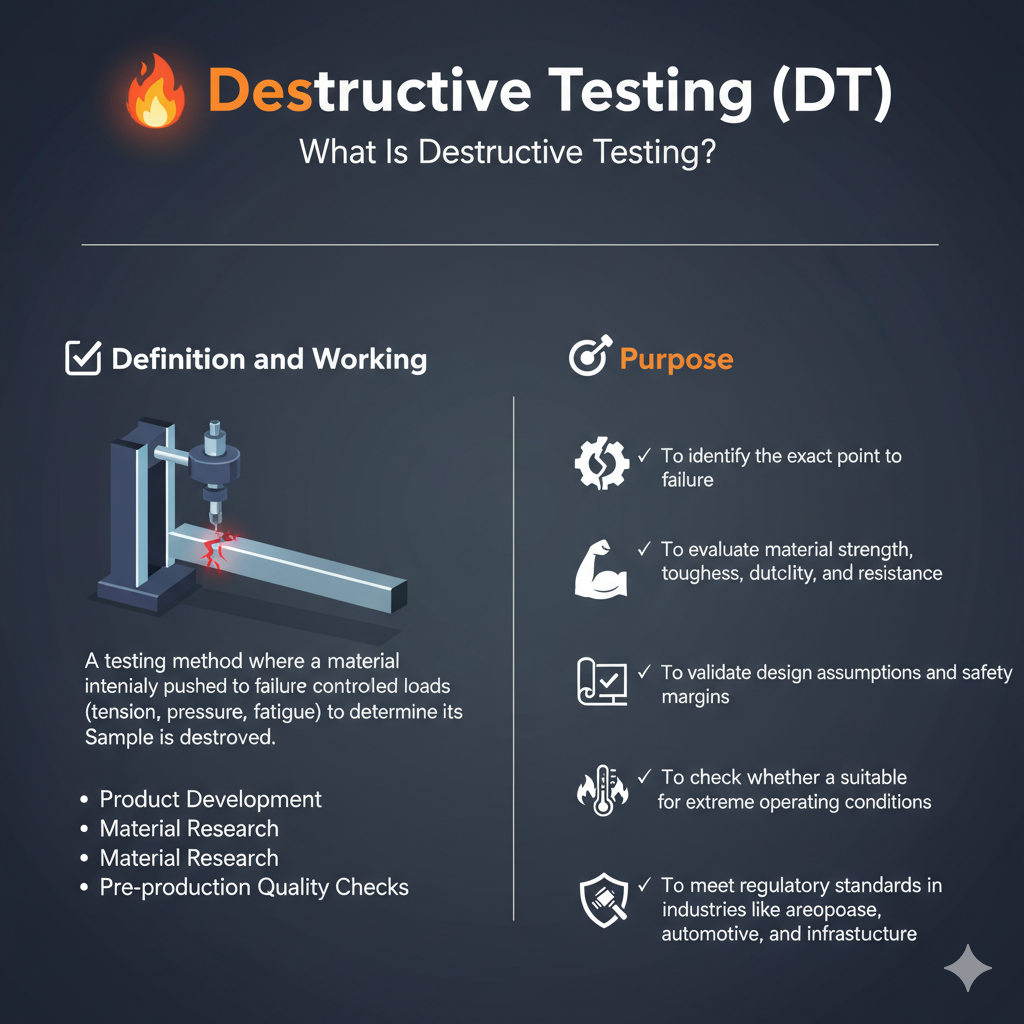Destructive vs Non-Destructive Testing (NDT): Complete Guide, Methods & Key Differences
Modern industries rely heavily on material testing to ensure product quality, safety, and long-term performance. Two major testing approaches used across engineering, manufacturing, construction, aerospace, and heavy industries are Destructive Testing (DT) and Non-Destructive Testing (NDT).
While destructive pile testing pushes materials to their breaking point to reveal failure modes, NDT evaluates assets without causing any damage. Understanding the difference between these two testing methods is essential for selecting the right quality control technique.
This comprehensive guide explains what destructive testing is, how it works, its types, applications, limitations, and how it compares with non-destructive pile testing.
What Is Destructive Testing?
Definition, Purpose & Working
Destructive testing (DT) is a testing method where a material, component, or structure is intentionally pushed to failure to determine its mechanical properties, durability, and performance limits. During DT, the sample undergoes controlled loads such as tension, pressure, fatigue, or environmental stress until it breaks or becomes unusable.
Because the specimen is destroyed in the process, destructive testing is mostly performed during product development, material research, and pre-production quality checks.
Why Destructive pile Testing Is Used
To identify the exact point of failure
To evaluate material strength, toughness, ductility, and resistance
To validate design assumptions and safety margins
To check whether a material is suitable for extreme operating conditions
To meet regulatory standards in industries like aerospace, automotive, and infrastructure
Common Equipment Used in Destructive pile Testing
-
High-speed cameras – capture the moment of failure in slow motion
-
Sound/vibration detectors – detect cracking or internal failure
-
Stress gauges – measure load, strain, and pressure during testing
Types of Destructive Testing Methods
Destructive pile testing includes various methods depending on the type of load, material, and intended application.
1. Corrosion Testing
Used to measure resistance to rust, pitting, or tarnishing in environments like seawater, chemicals, or humidity. Helps determine material suitability for corrosive conditions.
2. Fracture & Mechanical Testing
Evaluates how materials behave under different forces.
Includes:
-
Tensile (tension) tests – measure ductility, elongation & tensile strength
-
Charpy impact test – measures impact toughness
-
Peel/chisel test – checks weld strength
-
Crush testing – determines maximum compressive load
-
Bend tests – detect brittleness
-
Drop weight (Pellini) test – identifies ductile-to-brittle transition temperature
-
Hydrostatic pressure testing – identifies leakage under pressure
3. Aggressive Environmental Testing
Tests materials under harsh conditions such as extreme pressure, salinity, humidity, and temperature. Used for offshore structures, marine environments, and coastal buildings.
4. Fatigue Testing
Determines a material’s ability to withstand repetitive loading. Critical for:
-
Aircraft components
-
Automotive parts
-
Structural welds
-
Marine applications
5. Residual Stress Measurement
Identifies stress trapped inside materials that can lead to:
-
Fracture
-
Warping
-
Distortion
-
Fatigue failure
6. Tensile Testing
Applies stretching or compressive forces until failure to determine:
-
Ultimate tensile strength
-
Breaking strength
-
Maximum elongation
-
Material reduction properties
Applications of Destructive Testing
Destructive testing is widely used in:
-
Earthquake simulation (building design validation)
-
Automotive crash testing
-
Aerospace component validation
-
Fabrication and welding inspection
-
Materials science and research
-
Failure investigation
-
Safety equipment certification (PPE, helmets, etc.)
Limitations of Destructive Testing
Although effective, destructive testing has drawbacks:
1. Irreversible Damage
Once tested, the sample cannot be reused.
2. High Cost
Large structures or components can be expensive to destroy.
3. Time-Consuming
Requires setup, shutdown of operations, and detailed inspection.
4. Distance/Access Limitations
Requires physical contact with the test specimen.
Non-Destructive Testing (NDT) vs. Destructive Testing (DT)
Unlike DT, Non-Destructive Testing evaluates materials without causing permanent damage, making it ideal for in-service inspections, maintenance, and large-scale industrial operations.
Both methods identify defects, but NDT is preferred for cost-efficiency, safety, and operational continuity.
Types of Non-Destructive Testing (NDT)
NDT includes a wide range of inspection methods used for structural, mechanical, and surface-level defect detection:
1. Visual Testing (VT)
Surface inspection using the naked eye or remote cameras.
2. Ultrasonic Testing (UT)
Uses high-frequency sound waves to detect internal flaws.
3. Radiographic Testing (RT)
Uses X-rays or gamma rays to inspect welds and components.
4. Magnetic Particle Testing (MT)
Detects surface/subsurface cracks using magnetic fields.
5. Liquid Penetrant Testing (PT)
Uses dye to reveal surface defects.
6. Acoustic Emission Testing (AET)
Identifies active cracks through ultrasound bursts.
7. Eddy Current Testing (ECT)
Electromagnetic method to detect defects in conductive materials.
8. Leak Testing
Locates leaks in pressure vessels and pipelines.
DT vs NDT: Which Testing Method Should You Choose?
| Parameter | Destructive Testing (DT) | Non-Destructive Testing (NDT) |
|---|---|---|
| Sample Condition | Destroyed | Undamaged |
| Cost | High | Moderate to Low |
| Usage | Pre-production, research | In-service inspection |
| Accuracy | Highly accurate material properties | Accurate defect detection |
| Suitable For | Critical design validation | Maintenance, safety checks |
Choose DT when:
You need to know material limits
You’re validating a new design or prototype
Regulatory standards require failure testing
Choose NDT when:
You need ongoing inspection
The asset cannot be damaged
You want cost-effective testing
Final Thoughts
Both Destructive pile Testing and Non-Destructive pile Testing (NDT) play crucial roles in material evaluation and quality assurance. While DT provides deep insights into strength and failure behavior, NDT offers a safer, faster, and more economical approach for regular inspection.

